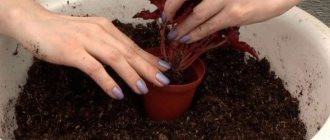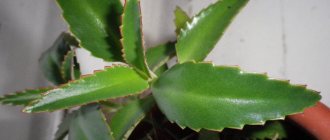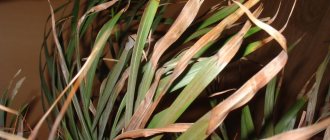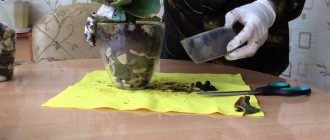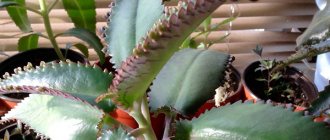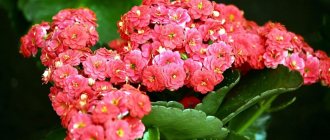Category: Succulents, Care Published 12/24/2018 · Comments: · Reading time: 13 min · Views: 3,962
Kalanchoe is not a simple interior decoration; it is a rather effective medicine from nature itself, which helps against many diseases. However, although the succulent itself has strong immunity, it is susceptible to some diseases and is not always able to withstand the onslaught of pests. What parasites and diseases of Kalanchoe are most common, how to identify signs of illness, and most importantly, how to save your pet from death?
Main reasons
- Lack of light - the plant stretches upward, and the leaves of Kalanchoe turn yellow or their tips dry out. Just move the plant to a brighter room.
- Stagnant air causes leaves to fall, ventilate the room more often.
Sunburn or severe crowding lead to spots on the leaves. Place the pots at a greater distance from each other and shade them.
- Lack of nutrients - stops growth and drops leaves. Replant the plant in new soil and fertilize it.
- An excess of peat or nitrogen in the soil leads to leaf curling. Just replant in new, properly prepared soil.
- Excessive watering or infection with root rot - the leaves become soft and fall off. Reduce watering and treat the root system.
- Excessive direct sunlight leads to complete yellowing of the plant. Rearrange the plant pot or shade it.
- If the Kalanchoe dries out or its leaves wither, it means that there has been no watering for a long time, the composition of the soil is incorrect, or there are pests in it. Water the plant in a timely manner, review the composition of the soil and check for the presence of insects.
You can read more about why Kalanchoe does not bloom here.
Prevention of diseases and pests
To avoid the development of dangerous diseases or parasite attacks, you need to practice prevention. It consists of strict adherence to plant care measures.
To avoid problems, the bush needs to be watered properly.
Proper plant care
To grow a strong and healthy plant, you need to follow a number of rules:
- Water the crop properly. The plant absorbs and retains liquid well. Therefore, overflow is more dangerous for him than lack of water. A slight drought will only benefit Kalanchoe. In hot weather, water the plant as needed.
- Maintain optimal lighting parameters. The plant can even withstand exposure to direct sunlight. In winter, the crop goes into hibernation. Therefore, it needs to be moved to a darker place. For the crop to bloom, it is necessary to reduce the length of daylight hours.
- Maintain the correct temperature. In warm weather, the culture requires a temperature of +18..+28 degrees. In winter, it will withstand lower parameters - +10..+16 degrees.
- Replant the plant in a timely manner. The roots of the culture are growing rapidly. Therefore, during the active development of the flower, it needs to be replanted. It is recommended to remove the Kalanchoe from the container very carefully so as not to damage the lump of soil.
- Trim the crop in a timely manner. During the flowering period, this procedure can only be performed if the plant is sick. Affected areas should be carefully cut off at the junction with healthy ones.
Important! It is recommended to spray the plant systematically. After the procedure, the leaves can be gently wiped with a sponge.
Kalanchoe is a popular indoor plant that is grown by many gardeners. At the same time, sometimes the crop may encounter diseases or pest attacks. To cope with problems, you should use special products and provide the flower with proper care.
Temperature
In summer, the most optimal temperature for Kalanchoe that blooms will be in the range from 23 to 29 degrees.
If the temperature is higher, it will be necessary to water the Kalanchoe more often, otherwise the flowers may dry out. At the same time, tropical Kalanchoe tolerates low temperatures well.
In winter and autumn, at temperatures above 10 degrees, Kalanchoe can be exposed to the air.
But since our climate in Russia is often harsh, there may be sudden frosts and icy winds, in the cold season it is better to leave Kalanchoe indoors.
Otherwise, in case of frostbite, you will have to cut off everything except the root and wait for new shoots to appear.
Lighting
The Kalanchoe indoor plant is not very demanding in caring for it.
This also applies to lighting, so you can place a pot of Kalanchoe in any room in the house where there are rays of sun.
Both partial shade and diffused light can be called favorable conditions for the plant.
Direct sunlight is safe for Kalanchoe and is needed, except for direct sunlight from 11 a.m. to 3 p.m. during the months of March to September.
Otherwise, there may be burns from intense sunlight, since the leaves contain a lot of moisture. Because of this, the growth of Kalanchoe may slow down or stop. Therefore, during the sunniest hours, you need to organize diffused bright light.
With sufficient lighting, the Kalanchoe leaves should have an outline of red honey fungus. If there is little light and the plant does not have enough light, the stems become elongated and the leaves become pale.
Watering
Kalanchoe is a succulent and is able to accumulate moisture in order to survive dry times.
And if you suddenly forgot to water the plant, then it’s okay. But excessive watering is even harmful to Kalanchoe.
When watering, the water should wet the ground thoroughly, and if there is excess left, it should be drained.
More frequent watering is allowed in the hot season, but also without excess. In winter you need to water twice a week, this will be enough, otherwise there may be rotting of the roots and the appearance of mold and fungus.
Air humidity
The air humidity in the room should be at a normal level; spraying cannot be done in winter, and not necessary in summer. Kalanchoe leaves can simply be wiped with a damp cloth to remove dust.
Diseases and control methods
- Powdery mildew - characteristic white spots with a fungal coating on the leaves. The reason is excessively dry and warm air. Water the plant more often and move it to a cool place. For treatment, spray with fungicides. If you react in time, the plant's health will be restored. Remember that powdery mildew spreads very quickly to other plants. Therefore, act immediately.
- Ring leaf spot - the stem of the plant rots and circular spots appear on the leaves. In this case, the flower begins to die and it is impossible to save it.
- Gray rot - sticky leaves with a gray coating, which later turn into mush. Replace the soil, water regularly, and maintain proper ventilation. For treatment, use fungicides and good temperature conditions.
- Late blight or late blight rot is brown spots or brown coating on the plant. This occurs due to poor ventilation and excess water in the soil. You need to reduce watering, select the right fertilizers, carry out preventive procedures and treat the plant with fungicides.
Reference. The plant is also often subject to stem rot - the trunk or stem turns black. This happens because your plant is frozen. The optimal temperature for the plant in winter is 15°C. It is important to calculate watering at this temperature.
The main diseases of Kalanchoe and their treatment at home
Late blight rot
Late blight is a fungal disease. Its appearance can be identified by brown spots in the branches of the shoots. The plant's growth is severely inhibited.
Infection can be caused by overflows, high indoor temperatures , lack of ventilation and excessive nitrogen content in the soil. Sudden temperature changes contribute to the rapid development of the disease.
Treatment of late blight rot is carried out with the help of fungicides, while watering is sharply reduced, and if possible, the soil should be replaced. As preventive measures, it is necessary to disinfect the soil before planting Kalanchoe, use clean tools and conduct regular inspections of the plants.
Gray rot
When infected with gray mold, Kalanchoe becomes covered with a gray coating and weeping spots. Over time, the plant completely rots. The disease spreads very quickly to healthy plants through air, tools and direct contact. The development of the disease can be triggered by excessive air and soil humidity, lack of ventilation, spraying or poor lighting. If an infection is detected, the Kalanchoe must be treated with a fungicide.
Powdery mildew
Powdery mildew manifests itself by the formation of a powdery white coating on the leaves of Kalanchoe. Gradually they begin to die off. The active development of the disease is promoted by dryness and high air temperatures. If measures are taken in a timely manner, the disease does not cause severe harm to Kalanchoe. Treatment is carried out by spraying with fungicides.
How to find out that a spider mite has settled on a plant, and how to fight it, read here.
And here you will find the answer to the question why anthurium leaves turn yellow.
Detailed instructions on how to get rid of whiteflies on indoor plants are at this address: https://cvetolubam.ru/belokrilka/
Ring leaf spot
Spots appear on the foliage in the form of rings, and the plant stops growing. Subsequently, the leaves become discolored, become coarser and take on an ugly shape. Unfortunately, the disease cannot be treated, so affected plants must be destroyed .
Stem rot
The appearance of black watery spots on the foliage and stems indicates infection of Kalanchoe with stem rot. The disease develops in conditions of high humidity. If spraying with insecticides does not help, then you need to destroy the diseased plant.
Common Pests
- Aphids are the most dangerous enemy of Kalanchoe.
Appears mainly in spring. If measures are not taken in time, it will spread to neighboring plants. Aphids are small green or black insects that appear on leaves or stems. She takes the sap of the plant and infects it with her poison. Damaged areas are covered with a sticky substance that prevents the plant from breathing. At the initial stage, it is difficult to notice the infection, since the insects are very small and settle on the back of the leaf. It can only be detected due to the unhealthy appearance of the plant. It becomes dirty and deformed. To get rid of aphids, you need to trim off the affected areas and burn them. Treat the remaining plant with an insecticide. Repeat once a week for a month. You can also use green potassium soap: dilute it in water and wash the plant with the solution. Can be replaced with laundry soap. - Multiclawed mites are small glassy mites. When it appears, the leaves and petioles become covered with brown scabs, and the plant tissues harden and become distorted. Wash off the insects with soapy water and treat the plant with an insecticide.
- Scale insects and false scale insects are insects with a two-millimeter body, covered with wax on top. They form a coating (in which sooty fungus is formed) and an accumulation of insects on the plant. The leaves turn yellow, fall off, growth slows down, and flowering stops. For treatment, immediately remove all insects and wash the plant with soapy water. Before removing insects, treat them with alcohol. You can use folk remedies (wipe the plant with a cotton swab and alcohol, use garlic or an old toothbrush).
- Mealybug - an insect that feeds on the sap of Kalanchoe. It propagates the fungus “black mold”. If measures are not taken, the plant will die. The appearance is determined by the appearance of white waxy discharge. For treatment, use mineral oil to spray the leaves.
How to reanimate Kalanchoe after an illness
To restore Kalanchoe after leaf disease, a soap solution is often used. Alcohol wipes are also highly effective. The procedure should be carried out three times a week.
Spathiphyllum - leaves turn yellow: causes and treatment
Instead of alcohol, it is permissible to use garlic infusion. To prepare it, you need to mix 5 crushed cloves with a glass of water, leave for 2 hours in a dark place and strain. Spray the crop with the prepared product.
When treating a plant, you should adhere to the following recommendations:
- provide the flower with complete care;
- eliminate pests in any available way;
- pinching;
- maintain normal parameters of humidity, light, temperature;
- apply fertilizers.
Thanks to strict adherence to the rules, Kalanchoe will be able to recover. On average, it is recommended to apply fertilizer once a month. Fertilizers for succulents are often used for this, but complex formulations can also be used.
Pinching prevents the crop from drying out. The procedure should be carried out with a disinfected instrument. This must be done carefully. If the bush is damaged, it should be sprinkled with charcoal.
This is interesting: Treatment of fruit trees from diseases and pests
Important! Fertilizers should be applied carefully. If there is an excess of useful elements, the plant will not withstand the rapid development of green mass.
Photo
And this is how leaf diseases and flower pests look in the photo.
Why do Kalanchoe leaves turn yellow, dry and wither?
Pathologies can be easily detected by the appearance of the culture. With the development of diseases in Kalanchoe, the leaves may turn yellow, dry out, wither or fall off. Sometimes the plant loses its ability to bloom.
A healthy flower has excellent decorative properties
These symptoms require timely initiation of treatment. Otherwise, the Kalanchoe may dry out completely.
Violation of the conditions of maintenance and care of the plant
Why do Kalanchoe leaves turn yellow? Most often, the cause of problems is a violation of the rules of crop care. To identify provoking factors, you should pay attention to the following symptoms:
- Yellowing of the foliage, drying of the tips and rapid growth of the crop indicate a lack of light. In this case, it is recommended to move the container with the flower to a brighter place. However, it is important to ensure that the pot does not stand on the windowsill.
- Leaves may dry out and fall off due to musty air. In this case, it is recommended to frequently ventilate the room.
- Dark spots on the foliage are caused by sunburn. The appearance of this sign is the basis for moving the pot to another place.
- A lack of nutrients can cause the plant's yellow leaves to fall off.
- Curling of leaves is observed when there is an excess of nitrogen or peat in the soil. In such a situation, it is necessary to move the bush to more suitable soil.
- Softening and falling leaves occur due to excessive watering or rotting roots. To solve the problem, you need to reduce watering or treat the root system.
- Dropping of shoots may be due to lack of irrigation. In this case, the plant may even dry out. Regular care of the crop will help to avoid this.
- Yellowing of leaf blades may be due to excess sunlight.
Important! The appearance of unwanted symptoms may be associated with the development of diseases or pest attacks. To cope with them, you need to carefully treat the culture.
Yellowing of the leaves of the crop is associated with improper care
White coating on leaves
- Powdery mildew
Powdery mildew is a common fungal disease of many plants grown in warm (21°C) and humid conditions. A symptom of powdery mildew is a white, powdery coating covering the leaves and twigs of Kalanchoe. After humidity and temperature drop below 20 °C, the white mycelium disappears, and brown spots of dead tissue appear in place of powdery mildew. Kalanchoe leaves curl, dry out and die. Flowers are distorted or the plant does not bloom at all. The fungal disease can be transferred to other plants growing nearby, by the wind or by water splashed during careless watering.
You can prevent powdery mildew by making sure that no water remains on the flower. Watering is done directly onto the ground, without soaking the leaves and stems. It is necessary to ensure good air exchange between plants and avoid accumulation, for example, on a windowsill, so that the wet parts of the Kalanchoe can dry quickly. If symptoms of powdery mildew are present, Kalanchoe is treated by spraying 3-4 times every 7-10 days with alternating fungicides. As an alternative, biopreparations Biosept (0.1 ml/200 ml water) and Bioczos (5 ml/250 ml water) are used for spraying.
- Mealybugs
Mealybugs are common pests of indoor plants. The most common is the citrus bug (Planococcus citri), which has a wide range of plant hosts. It happens that it settles on Kalanchoe.
Mealybugs are small (2-5 mm) insects with a flat, oval and soft body. The body is divided into segments and covered with white waxy scales. They feed on the shoots and undersides of Kalanchoe leaves. They cause weakening of plants, yellowing of leaves, slowing of growth and dwarfism of shoots. Feeding scale insects contaminate the leaves with a white woolly or powdery coating that looks like tufts of cotton wool. Like aphids and whiteflies, mealybugs secrete nectar, which becomes a breeding ground for fungi.
Application of Kalanchoe
The Kalanchoe plant is included in skin care cosmetics, ointments, and some tinctures and solutions. Treatment with Kalanchoe juice is most justified for obtaining an anti-inflammatory effect when applied externally: the juice inhibits the exudative phase of the inflammatory reaction and suppresses the formation of granulations in the proliferative phase of inflammation.
In surgery
Ointment and juice are actively used in surgery for the treatment of trophic ulcers, including post-thrombophlebitic, varicose, post-traumatic, purulent-necrotic formations, and bedsores. Used to clean the wound before suturing.
For ulcerative lesions, sterile gauze, folded in 4-5 layers, is moistened with juice, half diluted with 1% novocaine solution (to avoid burning). When it comes to diabetic ulcers, insulin is used instead of novocaine. In cases of contamination of the wound with bacteria and purulent discharge from the ulcer, an appropriate antibiotic to which the isolated pathogen is sensitive is added to the juice.
In dentistry
The juice is used in the treatment of advanced forms of gingivitis, periodontitis, and severe forms of stomatitis. It is sprayed onto the damaged mucous membrane several times a day. Such procedures help stop bleeding, cleanse purulent masses and epithelialize lesions.
In gynecology
Juice and ointment are used to accelerate the healing of perineal tears after childbirth, treatment of endocervicitis, cervical erosion, cracked nipples.
In ophthalmology
Plant preparations help cure corneal erosion and trauma, neuroparalytic, ulcerative keratitis, eye burns, etc., and are effective in patients in whom treatment with other drugs has not given the desired therapeutic effect.
In otolaryngology
The juice is used to treat chronic forms of tonsillitis, as well as runny nose, sinusitis in the early stages, and uncomplicated otitis media. The juice is believed to help repair damaged eardrums. A promising direction is the treatment of simple and toxicoallergic chronic tonsillitis in children using electrophoresis of Kalanchoe juice coupled with UHF therapy, carried out every other day.
In cosmetology
Effective in the fight against acne and fine wrinkles.
Video “Saving indoor flowers from pests”
From this video you will learn how to properly treat indoor plants and save them from pests.
Ticks
Mites settle on the underside of the leaf, and their appearance is caused by dry air in the room. The leaves of the flower quickly turn yellow, in addition, the insects themselves weave a thin web, which can be seen on the leaves. Leaves also curl and fall off. Therefore, if no measures are taken, the plant will simply die.
Get rid of nasty bugs using insecticides. You can also treat the flower with mineral oil or soap solution, and remove the pests themselves manually using napkins.
Aphids on Kalanchoe are a common problem that can be difficult to deal with. The cause is soil oversaturated with fertilizers, which these insects love. They settle on stems and the inside of leaves, so sometimes aphids are quite difficult to notice. Insects suck the juices from the Kalanchoe, secreting a sticky coating that prevents the flower from breathing.
If you see that the plant is beginning to smolder, you need to take immediate action. First of all, trim off the affected leaves. Then you can treat the flower with a soap solution. If you want to quickly get rid of pests, use insecticides.
Leaf diseases
Yellowing of leaves
Why does Kalanchoe turn yellow and what to do about it? This usually happens after flowering. The stem is stretched and exposed from below.
This is a sign of exhaustion. New soil and intensive fertilizing are needed.
Replant the plant in a new substrate. After transplanting, feed it with Zircon solution.
Why do Kalanchoe leaves often turn yellow and dry at the tips ? This is primarily due to a lack of boron and the flower needs to be fed with fertilizer containing a high content of this substance.
Curling leaves
Why do Kalanchoe leaves curl? Kalanchoe leaves curl, most likely due to damage to the root system.
The reason for this is excess water. Remove the plant from the pot and inspect the roots.
Damage must be cut out, the healthy part must be washed in a weak solution of potassium permanganate.
Then treat the cuts with charcoal powder and plant the surviving part in fresh soil.
Why do Kalanchoe leaves curl?
If the leaves curl and at the same time change color to burgundy, it means that the plant is in a place that is too lit and receives direct rays for a long time during the day.
In this case, shade the flower and spray it during the day.
The leaves are falling
Why does Kalanchoe shed its leaves? Kalanchoe fall off due to improper maintenance in winter. This happens when the flower is kept in a stuffy room, next to heating radiators.
If you notice this, move it to a cooler room. It is advisable that the temperature in it should not exceed 15 degrees. In this case, the winter will pass without losses.
So why Kalanchoe leaves fall Another reason for this may be coolness that is not combined with humidity - mold or black spots . It's a fungus. Fungicides will help destroy it.
Why does Kalanchoe wither?
What to do if Kalanchoe withers ? Why does the plant have soft leaves? The reason depends on the age of the plant.
If it is young, then such signs indicate a lack of water. But this is not necessarily related to quantity.
If the root is rotten, then moisture does not enter the leaves, but accumulates in the soil.
This can also happen with irregular watering.
If the soil dries out too much and is then watered too much, the plant may also wilt.
Watering should be done when dry, not dry.
In an adult Kalanchoe, the leaves wither due to aging. Rejuvenate him. Separate the cuttings and replant.
Black spots on leaves
If Kalanchoe leaves turn black, this indicates the presence of a fungus. This occurs due to an excess of moisture, the soil does not dry out and its aeration is impaired.
Change the soil, increase its looseness by adding sand. Adjust the watering in the future and then the leaves of the Kalanchoe will not turn black.
Brown spots on leaves
Dry brown crusts on the leaves are a disease of Kalanchoe called dropsy . It arises from temperature changes combined with waterlogging.
Move the Kalanchoe to a warmer, drier place and reduce the amount of water used. Make sure that cold air does not come into contact with it, for example, when ventilating.
White coating on leaves
The Kalanchoe is covered with a white coating due to the fact that the water for irrigation is too hard . It contains salts and lime impurities.
It needs to be softened: settled, filtered. The best remedy is freezing and then thawing.
To soften it, once a month you can add citric acid to it on the tip of a knife at the rate of one liter. You can add three percent vinegar - 1 teaspoon per liter. The liquid with acid is left to sit for two days so that all the salts settle, then drained and used for irrigation.
The leaves have fallen
Basically, Kalanchoe drops its leaves due to the fact that the plant freezes . This often happens when overflowing in a cold room. Move the Kalanchoe to a warm, dry room.
If it does not recover, change the soil. Plant the plant in almost dry soil and water only after 1-2 days, when the excess moisture has gone.
Kalanchoe grows upward and does not bloom
A special feature of Kalanchoe is its abundant flowering in the first year of life. So why does the flower then grow upward and not bloom? After the primary flowering, it enters a dormant phase.
It begins to stretch upward and does not bloom , accumulating leaves. To make it produce new buds, you need to form a bush.
Cut off the tops and root them. You will get new plants, and old specimens will begin to accumulate strength for budding.
What to do if the Kalanchoe has stretched out ? Remove the top couple of leaves from such shoots. After this, new shoots will grow on them.
Do this until your flower becomes a lush, rounded bush.
To stimulate flowering, they also reduce daylight hours to 12 hours. Put the Kalanchoe in a dark place at 7 pm, and at 7 am put it back in the light.
Why do Kalanchoe have small leaves?
The leaves become smaller and dull due to lack of light. Kalanchoe needs bright light for as long as possible during the day.
We do not recommend keeping it away from the window or on north-facing windows. The size is also affected by the sufficiency of nutrients, so the plant needs to be fed regularly.
This is especially necessary during the period of bud formation and flowering, since at this time it needs a lot of strength. Fertilize once every 14 days.
Chewed leaves
Why does Kalanchoe have nibbled leaves? Sometimes holes appear on the leaves, as if someone had chewed out pieces. These are burns that occur when spraying in direct sunlight.
Read also: Hibiscus - beneficial properties, uses, contraindications
The drops act like lenses, and the sun burns through the delicate skin. These areas turn into small holes.
Leaf diseases and pests of Kalanchoe:
Diseases of leaves of flowering Kalanchoe and treatment
Late blight rot
Brown spots indicate infection. The reason is excessive watering, poor ventilation.
In addition, this can happen due to a difference in soil and air temperatures of more than 8 degrees.
To prevent this disease from occurring, Kalanchoe should be planted in a loose substrate for good ventilation of the roots.
If disease develops, stop watering.
You can replace part of the soil with new one. It is also necessary to treat with fungicides (Profit Gold, Ridomil)
Gray rot
When it occurs, weeping spots covered with a gray coating appear on the leaves and stems. Like other diseases, gray mold develops when there is an excess of moisture in the soil and air, poor ventilation, and lack of light.
Treatment with systemic fungicides (Fundazol, Rovral) will help get rid of this.
Powdery mildew
The disease manifests itself in the form of white spots with a powdery coating, similar to mold on the leaves.
As a result, the leaves die.
The reason for the development of this disease is low humidity and high air temperature.
Under such conditions, the elasticity of the leaves suffers and they become vulnerable to fungus.
To prevent this from happening, you need to follow the watering rules. Spraying with Topaz and Fundazol will help.
Pests of Kalanchoe
One of the most dangerous enemies. These are small greenish-black sucking insects that cover the leaves first on the underside. Gradually the entire plant becomes covered with the pest. The leaves begin to lighten and become sticky.
This happens because the aphid secretes a toxic substance. The breathing of the leaves is disrupted, and the plant may die. Aphids also get into flower buds; they do not bloom and fall off.
Leaves affected by aphids are cut off and burned. Healthier parts are treated with insecticide. A good auxiliary product is laundry soap. Surfaces are washed with its solution before treating with poison.
But it will not be possible to destroy aphids in one go. Treatment is carried out 4 times at weekly intervals.
the lower leaves of flowering Kalanchoe turn yellow and ? This insect is approximately 2 millimeters in size, its body is covered with a brown shell - scale insect .
This coating protects the scale insect from poisons, making it difficult to fight.
Why do Kalanchoe leaves dry out and fall off ? This happens because the scale insect settles on the underside of the leaves. Thus, they contribute to disruption of their nutrition.
A plaque of insect colonies appears. Plus, sooty fungus grows in the thyroid secretions. This worsens the condition of the plant.
with scale insects can be prevented by ventilating the room and spraying m (scale insects do not like moisture). If the pest does appear, collect it and wash all surfaces with a solution of laundry soap.
Before doing this, wipe them with vodka or alcohol, this will make the scale insects easier to wash off. There are no special poisons produced for this pest, so use any.
What to do if Kalanchoe still dies? There are folk remedies against this pest. This is an infusion of garlic - 6 cloves per glass of water, infused for 3-4 hours and filtered.
The mealybug is a white sucking insect. You can notice it with the naked eye.
When asked why the leaves of Kalanchoe dry out, the answer can be that the plant is affected by a scale insect . It covers the leaves with a waxy coating, the entire above-ground part, and multiplies with enormous speed. A sooty fungus settles on the excretions of scale insects. Kalanchoe affected by scale dries and does not develop.
If you notice the appearance of a pest, take action immediately.
Wash off the scale insects with soapy water and a cotton swab. Then spray the plant three times with an interval of 10 days with infusion of tobacco, garlic, or treat with alcohol tincture of calendula.
If the leaves of Kalanchoe dry out , it means the plant is severely affected by scale insects, carry out 3 treatments at the same interval with Aktara, Tanrek, Fitoverm, Mospilan.

